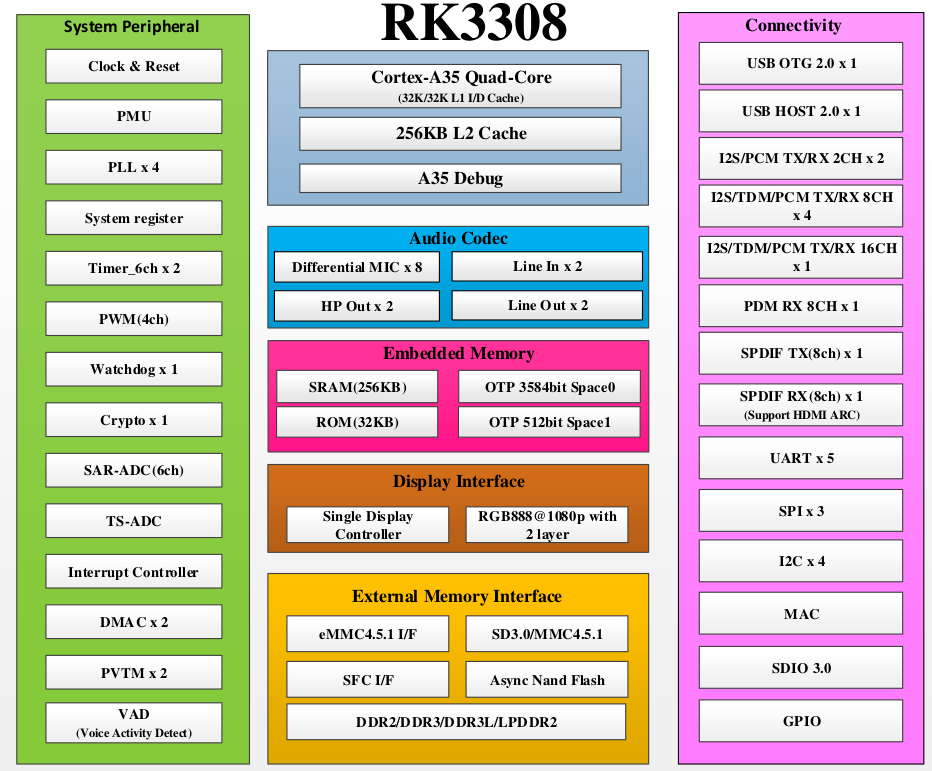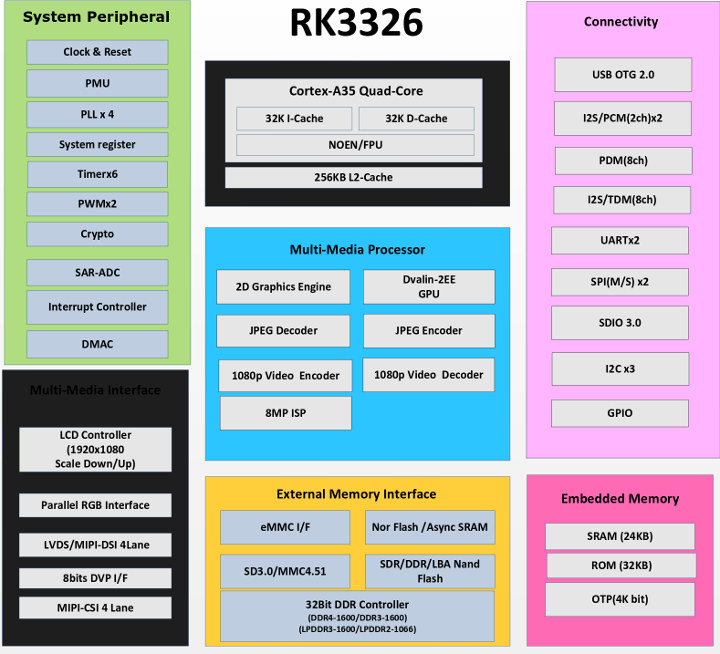Rockchip unveiled their first Arm Cortex-A35 processors with RK3326 “Gemini” and RK3308 SoCs last March. Both are designed for Smart AI solutions, and the company showcased two development kits for smart speakers and smart displays based on the new processors.
We’ve already known the basic details for the processors for some times, with for example RK3326 featuring a Mali-G31 Dvalin GPU, but I’ve now been informed more details have surfaced since Rockchip published documentations including datasheets.
Rockchip RK3308

Key features and specifications:
- CPU – Quad-core Arm Cortex-A35 64-bit Armv8-A CPU with NEON, ARMv8 Cryptography Extensions, 256KB unified system L2 cache, and VFPv4 FPU,
- System Memory – 256KB internal SRAM, support for DDR2, DDR3/DDR3L, LPDDR2 external memory up to 512MB
- Storage
- Internal BootROM
- OTP – Support 4K bit Size, 3.5K bit for secure application
- External I/F – 8-bits Asynchronism Nand Flash, eMMC 5.1, SPI Nor/Nand Flash, SD Card all bootable;
- System Components
- CRU (Clock & reset unit)
- PMU (Power management unit)
- Timers – 6x 64-bit timers for non-secure applications, 6x 64-bit timers for secure application
- PWM – 4x PWM with interrupt-based operation
- 32-bit watchdog counter
- Interrupt Controller with support for 4x PPI interrupt source and 89x SPI interrupt sources input from different components, 16 software-triggered interrupts
- DMAC – 2x embedded DMA controllers for peripheral system
- Trust Execution Environment system with Arm TrustZone technology
- Cipher engine – SHA-1, SHA-256/224, SHA-512/384, MD5 with hardware padding;
- Video Output Processor (VOP) – Support parallel RGB LCD output interface RGB666 / RGB565 up to 1080p; dual layer support
- Audio Interface
- 2-channel / 8-channel / 16-channel I2S up to 192 KHz sample rate
- 8-channel PDM up to 192 KHz sample rate
- 8-channel TDM up to 192 KHz @ 2-ch, 48 KHz @ 8-ch
- SPDIF Rx and Tx up to 192 KHz
- Voice Activity Detection (VAD) with multi-mic array support
- Embedded Audio Codec -24 bit DAC which support stereo headphone out and line out
- Peripherals
- SDIO interface compatible with SDIO3.0 protocol
- MAC 10/100 Ethernet Controller
- USB 2.0 OTG, USB 2.0 Host
- 3x SPI, 4x I2C, 5x UART
- GPIOs
- Temperature Sensor(TS-ADC)
- 10-bit Successive Approximation ADC (SARADC) with up to 1MS/s sampling rate
- Package – TFBGA355 (13mm x 13mm; ball size: 0.3mm; ball pitch: 0.65mm)
RK3308 processor supports external displays but without 2D/3D accelerator you’ll be limited to what you can do, and the user experience may feel sluggish.
You’ll find the datasheet (in English) and other documents about DuerOS and Linux (in Chinese) in RK3308 folder.
Rockchip RK3326

Rockchip RK3326 is somewhat similar but offer more displays options, video input (camera) support, as well as multimedia processors for 2D, 3D and video encoding/decoding.
Key features and specifications:
- CPU – Quad-core Arm Cortex-A35 64-bit Armv8-A CPU with NEON, ARMv8 Cryptography Extensions, 256KB unified system L2 cache, and VFPv3 FPU,
- System Memory – 256KB internal SRAM, support for DDR3/DDR3L, DDR4, LPDDR2, LPDDR3 external memory up to 4GB
- Storage
- Internal BootROM
- OTP – Support 4K bit Size, 3.5K bit for secure application
- External I/F – 8-bits Asynchronism Nand Flash, eMMC 5.1, SPI Nor/Nand Flash, SD Card, Toggle Nand flash all bootable + 8-bit ONFI Nand flash
- System Components
- CRU (Clock & reset unit)
- PMU (Power management unit)
- Timers – 6x 64-bit timers for non-secure applications, 2x 64-bit timers for secure application
- PWM – 2x PWM with interrupt-based operation
- 32-bit watchdog counter
- Interrupt Controller with support for 3x PPI interrupt source and 128x SPI interrupt sources input from different components, 16 software-triggered interrupts
- DMAC – 1x embedded DMA controllers for peripheral system
- Trust Execution Environment system with Arm TrustZone technology
- Cipher engine – SHA-1, SHA-256/224, SHA-512/384, MD5 with hardware padding;
- Video Codec
- Video Decoder- MPEG-4, H.264, H.265/HEVC, VP8, VC-1 up to 1080p60
- Video Encoder – H.264 video encoder up to 1920×1080 30FPS, or 2x 720p @30fps
- Graphics Engines
- 3D Graphics Engine with support for DirectX 11 FL9_3, OpenGL ES 1.1, 2.0, and 3.2, Vulkan 1.0, and OpenCL 2.0 Full Profile
- 2D Graphics Engine with scaling, rotation, alpha blending, etc…
- Video Input Interfaces
- 8-bit DPI interface up to 150 MHz
- MIPI CSI Tx interface with 4-lane @ 1 Gbps max each
- VIP block with support for YCbCr422 8-bit, Raw 8bit/10bit/12bit, CCIR656(PAL/NTSC), JPEG inputs, as well as YCbCr422/420 output
- 12-bit ISP
- Display Interfaces
- 24-bit RGB parallel display interface up to 1080p60
- MIPI DSI interface up to 1080p60
- LVDS interface up to 1280×800 @ 60 Hz
- Video Output Processor (VOP) – Support parallel RGB LCD output interface RGB888 / RGB666 / RGB 565 up to 1080p; dual layer support + HW cursor layer
- Audio Interface
- 2-channel / 8-channel I2S Tx/Rx interfaces up to 192 KHz sample rate
- Up to 8-channel PDM up to 192 KHz sample rate
- Up to 8-channel Tx/Rx TDM up to 192 KHz
- Peripherals
- SDIO interface compatible with SDIO3.0 protocol
- USB 2.0 OTG
- 2x SPI, 4x I2C, 2x UART
- GPIOs
- Temperature Sensor(TS-ADC)
- 10-bit Successive Approximation ADC (SARADC) with up to 1MS/s sampling rate
- Package – TFBGA395L (14mm x 14mm; ball size: 0.3mm; ball pitch: 0.65mm)
RK3326 may come with extra multimedia features, and supports more memory up to 4GB, but it drops Ethernet, USB 2.0 host interface, and SPDIF. There’s also no specific mention of voice activity detection, but the multiple Audio Tx/Rx interfaces should mean it can still handle microphone arrays.
Again, you’ll find RK3326 datasheet in English, and some Linux documentation in Chinese in RK3326 folder in Github. Also be prepared people to confuse RK3326 and RK3328, or at least typos in the future including from yours truly 🙂
Thanks to TLS for the tip.

Jean-Luc started CNX Software in 2010 as a part-time endeavor, before quitting his job as a software engineering manager, and starting to write daily news, and reviews full time later in 2011.
Support CNX Software! Donate via cryptocurrencies, become a Patron on Patreon, or purchase goods on Amazon or Aliexpress





Any word on the power draw of each of the two?
Re typos, beginning of first paragraph after the 3326 specs ; ]
Wrt typo, just checking if somebody was paying attention 😉
The datasheet have limited power consumption info. RK3308 has a bit more:
Standby 0.01 @AVDD1V8 mA
Mono Recording 2.5 @AVDD1V8 mA
Mono Playback 3 @AVDD1V8 mA
The RK3308 still being stuck on fast ethernet and USB 2.0 is such a backward step.
And can’t they be more inventive with names like Gemini, which just adds confusion for the uninformed user think that they might be getting Gemini lake.
Why should surveillance equipment (‘smart speakers and smart displays’) need Gigabit Ethernet and USB3.0? These things just need a lot of audio/video inputs to do their job…
To exfiltrate the collected data in shorter bursts?
What iot device are you planning to build that require gigabit and usb3? No flaming,I might want one too.
Maybe 8K or 16K cameras ( Just a silly joke 🙂 )
I think you misunderstand the market for these chips. These are Cortex-A35, so a step below the A53/A55 and intended for lower power devices. The 3326 relies entirely on SDIO for Wi-Fi and has a single USB 2.0 OTG port. It should tell you that these chips are not intended for higher-end applications.
But I want to use it as a NAS!!!!1!111!!11! Mimimimi! ZFS!!!!! BTRFS!!!!! RAID!!
Steilvorlage @TKaiser 😉
RK3326 does not appear to be as good as Allwinner V3. h.264 encoding speed half performance of V3. CPU is slower too. They did add TrustZone which is sorely lacking from V3/V5. Allwinner — it’s a security camera, give us TrustZone! Significantly better video output than V3. Of course Allwinner V3 is $2.80. This chip appear to be more suited to cloning the Amazon Echo Show than for making a security camera.
I think the second one is aimed at cloning Amazon Echos? Not sure what I would do with RK3308, but will have to be priced at less than $2.50 to be competitive.